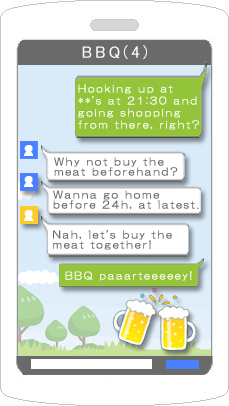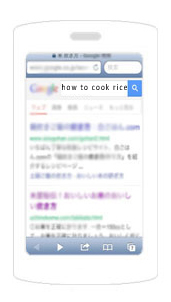Field Survey on the Use of Smartphones by Junior and Senior High School Students
1. Introduction
We, the student research team of Dr. Takeyama's Seminar at Keio University carried out a research on trends in media communication, targeting 20 students of junior and senior high school age, both boys and girls, in areas around Tokyo. First, the team conducted group interviews to ask questions on their daily life and smartphone usage, and then employed a new research method using an instant messenger app. In this manner, comparison between the realities of high-school students now and then was made.
2. Findings from the Group Interview Sessions
Below are results from the group interviews.
a) Some high school students use the instant messenger app to "ask for advice on studying" or "just to have a chat" with teachers. Teachers used to be unapproachable and too special to talk to, and communication between teachers and students seemed rather formal, when we, university students, were in high school. This implies that the emotional distance has become closer now in the smartphone-native generation (smartphone and tablet generation).
b) One high school student reported that they utilized a group video chat app with friends to see each other online when studying alone at home before their examinations. This is because looking at friends who are studying hard through a smartphone's built-in camera helped them to concentrate on their own studies with a feeling of tension. It can be inferred that the feeling of connectedness through the Internet is increasingly approaching that of face-to-face communication in the "smartphone-native generation."
c) An interview with junior high-school girls made it clear that bullying among friends took place not only in their real relationships but also through the instant messenger app, for example, through abusive posts or forced withdrawal from the group chat. Presumably, the spread of smartphones has made bullying easier by removing the restrictions of time and place.
d) A male senior high school student mentioned that many of his friends seemed so wrapped up in game apps, and run these programs even during a recess of 10 minutes or so, in order to participate in random event-battles, which take place only at certain limited times. The arrival of smartphones has enabled people to play computer games at any time, and they can intrude in high school life easily on end.
e) A senior high school boy uses different messenger apps with his girlfriend and with other friends. It seems students employ different communication tools depending on who they talk to. When telling someone they like her/him, some students preferred using e-mail, because it seems more courteous and can convey the importance of the message. Thus, "smartphone-natives" tactfully utilize various communication apps within a single smartphone under different situations.
f) A senior high school boy informed us of a popular form of amusement among friends to invite official accounts of celebrities or companies, which automatically replies to posts or messages received in their chat group on the instant messenger app. Although their target of interest has shifted from real-life to digital objects, the imaginative way of having fun by using things beyond its intended purpose remains the same since our high school days.
g) Some junior high school boys using iPod touch get Internet access by tethering *1 their friends' iPhones. This means that even junior high school students understand how the communication technology works, and some try to connect to the Internet even when they are with friends or on the way to school.
h) The interviews with junior/senior high school girls have made it clear that they prefer cafés with free Wi-Fi because many of them use iPod touch. It seems the public wireless LAN systems in urban areas are now an essential network infrastructure for high school students.
i) A male senior high-school teacher expressed a negative opinion of children's smartphone use. A high incidence of smartphone-related trouble in his classroom was mentioned, for example, conflicts among students, game apps playing during recess, juvenile delinquency due to SNS communication with strangers. As university students, we feel it is important for both teachers and students to thoroughly understand the benefits and risks as well as the adequate usage of smartphones.
3. Lifestyle Survey through an Instant Messenger App
In order to better understand the actual lifestyle of senior high school students, which could not be ascertained in group interviews, we conducted research using the instant messenger app that they use on a daily basis. Through this app, three male senior high school (HS) students and two female university students exchanged messages for a week on a one-to-one basis. In the research, the male HS students reported on their daily life using only stickers and images, while the female university students responded to them using stickers only. Our intention was to alleviate the HS boys' load, as just sending stickers seemed to be an easy task.
Below are some of the features of the "smartphone-native" generation that became clear from the research.
a) Fashion apps to cultivate good taste
Looking back, we used to subscribe monthly fashion magazines to get the latest information. However, the targeted HS boys catch up with the latest trends by installing their favorite fashion brands' apps on their smartphones.
b) The instant messenger app chat group for their BBQ party
In Fig.1, the screen on the right shows the communication between a male HS student and a female university student, and the left shows the conversation among the HS boys, both of which are mock images created by CRN. It appears that they discuss and decide the details among all of the members using the group chat, rather than an organizer making the decision and sending it out to all the rest. In addition, among the photos sent by the boys to describe the BBQ party, using his smartphone, he sent me a screenshot of a search on how to cook rice, which he did not know how to do, as shown in Figure 2.
 |
 |
|

Figure 2
*Images created by CRN based on actual screenshots.
c) Viewing comedy shows in spare time
Some of the photos sent by the HS boys were screenshots of watching YouTube on smartphones. The members of our research team mostly watch it on a PC rather than on a smartphone, since we were familiar with PCs in the days before smartphones. As revealed in the group interviews, junior high and senior high school students seem to avoid using PCs.
4. Conclusion
In the present situation, smartphones are often regarded as a cause for social problems of addiction or bullying on the Internet, and the majority holds negative views regarding their use. This research helped us to understand the features and background of the "smartphone-native" generation's behavior and attitude, which are different from our generation, while we also discovered the positive aspects of smartphone use by junior/senior high school students to a certain extent. Particularly, many of the junior and senior high school students benefit from the instant messenger app in many ways, by asking for casual advice from teachers on their study or daily life or promoting classroom activities with the app's functions. Therefore, schools and parents should not just regulate the use of smartphones, but they also need to understand their positive aspects. Both adults and youths need to work together to build a more favorable environment and means of desirable smartphone use.














